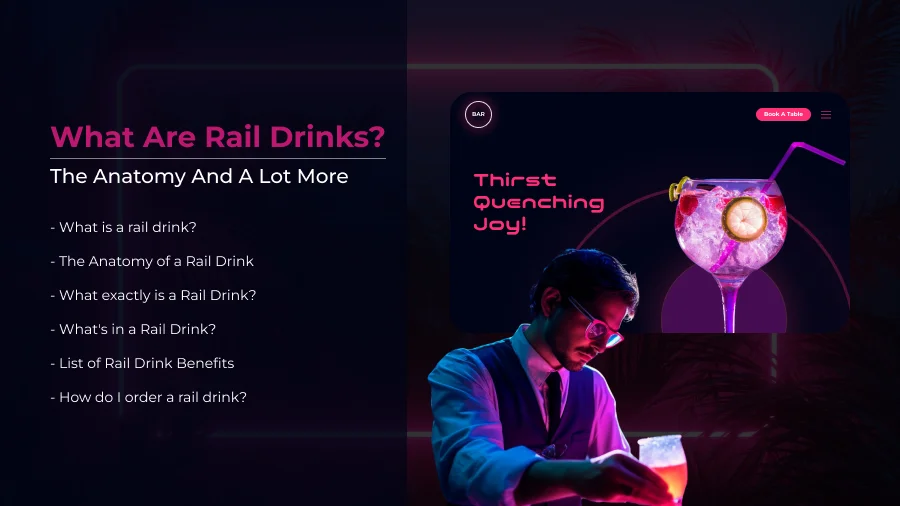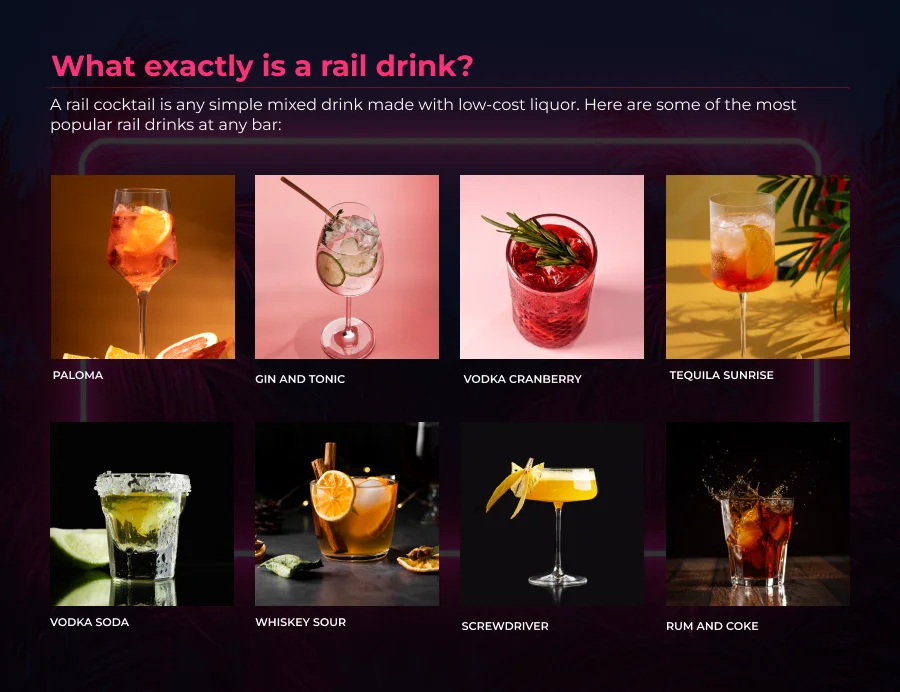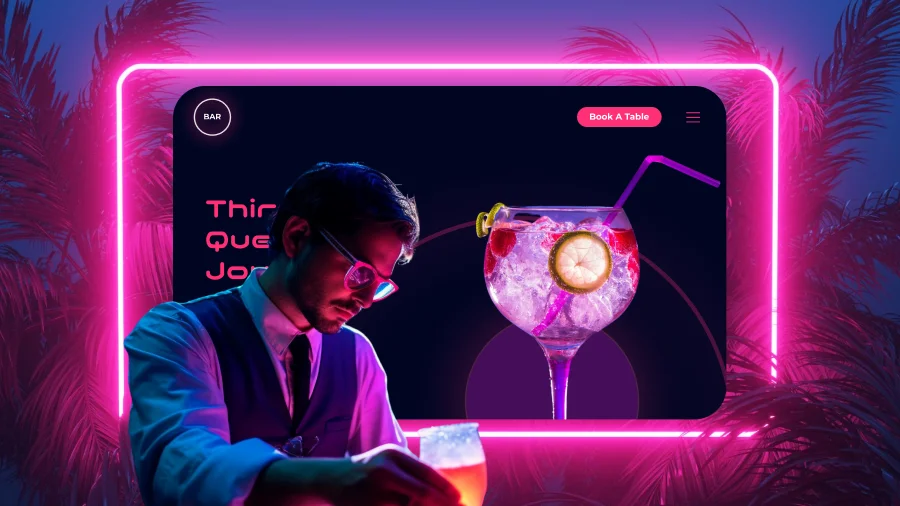What Are Rail Drinks? The Anatomy and a Lot More
All around the world, rail drinks like rum and coke, vodka cranberry, and gin and tonic hold a special place in the hearts of bar enthusiasts. Classic drinks are more than just libations; they're the essence of the word “classic" and the core of any bustling bar.
Among the most ordered rail drinks are rum and coke, vodka cranberry, and gin and tonic. A rail drink maximizes revenue while minimizing costs (and is also one of the most popular drinks at a bar).
Our blog post will cover the anatomy of rail drinks, what ingredients go into them, the benefits, and how to order them.

A rail drink is an alcoholic beverage served on a rail, which is a tiny, narrow platform. The rail is often composed of wood or metal and sits atop a bar. Rail beverages are usually served in glasses small enough to fit on the rail.
Rail cocktails are often made with a spirit, such as vodka, gin, rum, or whiskey, and a mixer, such as soda water, juice, or lemonade. Rail cocktails are typically garnished with a lemon or lime slice.
Rail drinks are popular at bars and nightclubs because they are easy to make and serve. Furthermore, rail cocktails are frequently less expensive than mixed drinks made with more expensive spirits.
Also, check out our latest guide on essential features for the POS of the bars.
The Anatomy of a Rail Drink
Rail drinks, often known as “well drinks," are an important part of the booming world of bartending. These cocktails, known for their cost and simplicity, have earned their place as the workhorse of any excellent bar. But what precisely is a rail drink? Let's have a look at their anatomy.
The Name
The name “rail drink" refers to the location of the liquor used to make them. Most bars keep their most frequently used, and often less expensive, liquors on a 'speed rail' or 'well' for easy access. Rail cocktails are named after their convenient location, which is usually right in front of the bartender.
The Alcohol
Liquor is the soul of any rail drink. Depending on the bar, the choices may include vodka, rum, gin, tequila, whiskey, and possibly generic brandy or scotch. These are the base spirits that give the primary flavor of each cocktail. It's vital to remember that rail liquors are typically not top-shelf or premium brands, but rather lower-cost alternatives with a powerful flavor.
The Mixer
Rail cocktails come to life when liquor is blended with one or more mixers. Soda water, tonic water, cola, ginger ale, lemon-lime soda, and other fruit juices like cranberry, orange, and pineapple are popular mixers. Depending on the customer's preferences and the type of cocktail being mixed, bartenders may also add other mixers such as cream, grenadine, or sour mix.
The Proportions
A rail drink's anatomy also includes its proportions. The basic cocktail mixture of one part liquor and two parts mixer is used in most rail beverages. However, this can vary depending on the drink or the customer's tastes.
The garnish
Last but not least, garnishes round out rail drinks. They not only make the drink more visually appealing, but they can also improve the flavor. In the case of a Bloody Mary, garnishes like lime wedges, lemon slices, cherries, olives, or even a stick of celery are common.

What exactly is a Rail Drink?
A rail cocktail is any simple mixed drink made with low-cost liquor. Here are some of the most popular rail drinks at any bar:
- Rum and coke
- Gin and tonic
- Vodka cranberry
- Screwdriver
- Vodka soda
- Whiskey sour
- Tequila sunrise
- Paloma
- Long island iced tea

What's in a Rail Drink?
So, what exactly is in a rail drink? Well, that depends on the drink you're ordering. There are, however, a few key elements that are always present. For starters, there is always some type of alcohol present. This can be vodka, whiskey, or rum. Second, there is always some sort of mixer. This is typically soda water or ginger ale. Finally, there is always the option of a garnish. This can range from a lemon slice to a cherry.
So, the next time you order a rail drink, you'll be prepared!
List of Rail Drink Benefits
Here are the benefits of creating a rail drink list at your restaurant.
Profit margins are high
Rail cocktails will be big profit drivers for your restaurant or bar due to the lower-cost ingredients mixed with higher sales. Drinks have the highest profit margins of any item on a restaurant menu, and rail drinks take full advantage of this advantage.
Simple preparation
Rail drinks are quick and simple to mix for your bartenders. Rail drinks can be made fast with only a few ingredients, making your bartender's job easier and more money flowing into your business.
They are popular among visitors
Rail cocktails are extremely popular among guests. They are an affordable and reliable drink option, and many people order them when they go to a pub.
Rail drinks for everybody!
Rail cocktails are a terrific way to boost your restaurant's profit margin while also keeping your guests and crew happy.
How do I order a Rail Drink?
When ordering a rail drink, keep a few things in mind. First, decide the type of alcohol you want in your cocktail. Vodka, gin, and rum are all popular rail drinks. Second, choose whether you want your drink sweet or sour. Third, consider the type of mixer you want to use. Soda water, lemonade, and cranberry juice are popular rail drink mixers.
After you've set these factors, it's time to order your drink! When ordering a rail cocktail, mention what type of alcohol you want. You can say, “I'll have a vodka rail drink." If you want your drink to be sweet, ask for it to be made with simple syrup. If you like a sour drink, get your rail drink mixed with lime juice.
Soda water is a popular mixer choice for rail drinks. You can, however, ask your drink to be made with lemonade or cranberry juice. When ordering your drink, make sure to specify the sort of mixer you want.
You may be sure to enjoy a great rail drink that is personalized to your preferences if you follow these suggestions! Discover how to open a bar with our blog on 8 Simple Steps to Opening a Bar
